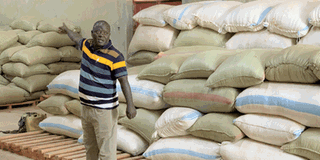Trade stock financing to benefit agribusinesses

Abdallah Okoa displays some of his produce in the store. PHOTO/SHABIBA NAKIRYANGA
What you need to know:
- Banks are currently offering structured commodity trade financing through which farmers are able to borrow against their agricultural inventory which can be used as collateral.
Abdallah Okao, a grain trader in Lira- the marketing hub of grain trade in Uganda, is confident in the growth of his business and the sector at large as more banks take interest and become adaptable in financing the sector players.
One of the main challenges in the agribusiness remains the changing seasons of harvest and plantation which translate into the high and low seasons, making it difficult and expensive for players to borrow and maintain long term loans.
According to Okao, “Financing from the bank has been timely especially when we have all the requirements that the bank needs. We have experienced reduction in processing time and the way this facility is structured as an annual facility that is broken into two parts. Every six months, you can use it and put it back and again write to request for a new loan facility and it is released within a period of four days only. So the processing time is low and they are not so strict on requirements as long as the value of the security is secured.”
Agribusiness financing
Equity Bank Uganda recently joined the list of banks currently offering structured commodity trade financing through which agribusiness owners are now able to borrow against their agricultural inventory which can be used as collateral for security and repayment, undermining the conventional ways of lending and borrowing.
“Commodity financing is not something that has been tried yet and I think it is sustainable. Sometimes, the loan facilities that we borrow may not be sufficient to run the available volume of commodity in stock due to bumper harvests. We have previously asked banks to come in to support us from a stock financing level and I’m glad that this is something they’ve put into consideration. It is possible because we’ll have the Bank on one side and the aggregator on the other, working closely together,” says Okao of the new loan structure.
“If there is any fluctuation in price, the bank is aware. If there’s an issue of timeliness of aggregation and you have to sell by a certain time, the bank will be aware. For instance, there is a situation like in this year where soya bean prices kept on increasing. It started from Shs1,000 and is right now at Shs2,300. You can therefore engage the bank and offset the loan with the profit made. However, where there may be a price dip, the borrower can engage the bank to agree on what happens to the interest rate agreed upon or the duration of the loan repayment period,” says Okao.
“The challenge really happens when there is a bumper harvest like we experienced last season. We have sufficient storage for instance ours can store up to 10,000 metric tonnes but there are those that can run only 1,000 metric tonnes so they’re undercapacitated yet they could run a bigger capacity with this sort of arrangement with finance institutions.”
Farmer’s challenge
James Odur, the Business Development Manager at Equity Bank Lira Branch notes, “With commodity financing, most of our clients who are trading in agribusiness have a challenge of collateral. Commodity financing addresses this issue and the duration of loan repayment. The longer a loan facility, the more one pays in interest which becomes expensive. The biggest challenge we have in explaining this to them is getting them to realise that first of all, this facility is a short term financing solution which fits within their trading cycle at low interest rates. Most of them are used to the conventional way of borrowing and they don’t realise the risk inherent of long term borrowing. We have decided to give it this structure so that during the time they don’t need the money, they are not indebted to the bank.”
Tip
Clean and lubricate the seed and fertiliser drives and metering units and replace any defective parts. Check the seed and fertiliser tubes ensuring they are in good condition and are not blocked and replace as necessary.




